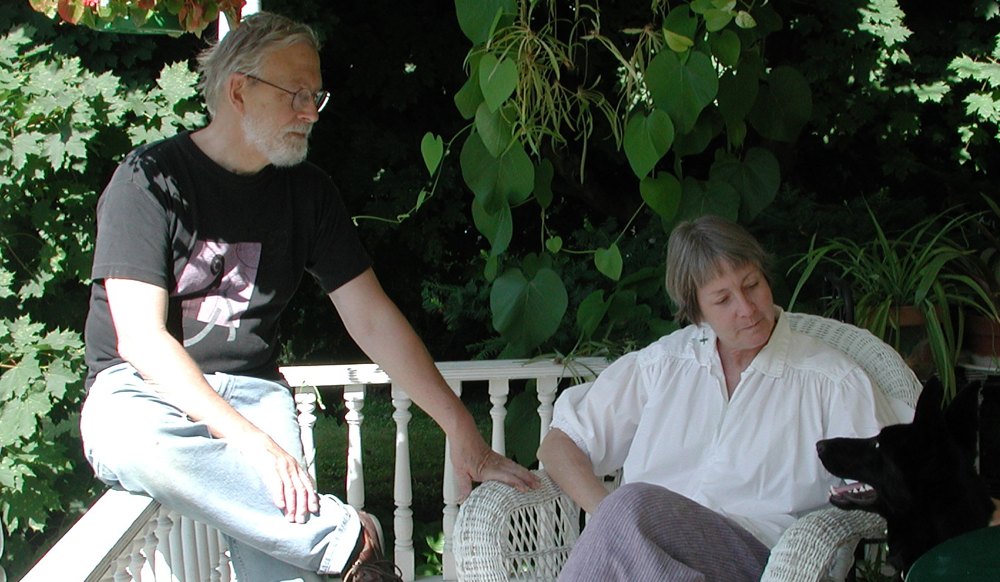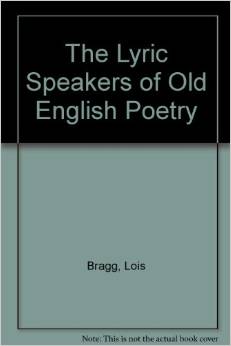Edna Edith Sayers
(f.k.a. Lois Bragg)
P.O. Box 176
Willard, New York 14588
edna@eesayers.net

Will, Edna, and Dorothy Sayers
|
Edna Edith Sayers has published on Old English and Old Icelandic literature, medieval finger alphabets and runes, disability studies, and Deaf history. She is the author (as Lois Bragg) of The Lyric Speakers of Old English Poetry (1991) and Oedipus Borealis: The Aberrant Body in Old Icelandic Myth and Saga (2004). She is also the editor of Deaf World: A Historical Reader and Primary Sourcebook (2001). Most recently, she has edited Outcasts and Angels: The New Anthology of Deaf Character in Literature (Gallaudet 2012) and Mrs. Sigourney of Deaf Hartford (co-edited with Diana Moore). She lives in Willard, New York, on Seneca Lake, retired from the Department of English of Gallaudet University, Washington, D.C., after nearly three decades of teaching English and world literature there and elsewhere.
|
Books |
WORK IN PROGRESS:
The Life and Times of Thomas Hopkins Gallaudet (with Diana Moore).
"Isaac Kilborn, a Deaf Puritan."
This study of Kilborn's life in seventeenth-century Rowley, Massachusetts, is made possible by newly available church records that include several narratives, as well as other details, about his life. |
|
RECENTLY PUBLISHED (April, 2013):
Sayers, Edna Edith, and Diana Moore. Mrs. Sigourney of Hartford: Poems and Prose on the Early American Deaf Community. Gallaudet University Press, 2013.
Lydia Huntley was born in 1791 in Norwich, CT, the only child of a poor Revolutionary war veteran. But her father’s employer, a wealthy widow, gave young Lydia the run of her library and later sent her for visits to Hartford, CT. After teaching at her own school for several years in Norwich, Lydia returned to Hartford to head a class of 15 girls from the best families. Among her students was Alice Cogswell, a deaf girl soon to be famous as a student of Thomas Hopkins Gallaudet and Laurent Clerc.
Lydia’s inspiration came from a deep commitment to the education of girls and also for African American, Indian, and deaf children. She left teaching to marry Charles Sigourney, then turned to writing to support her family, publishing 56 books, 2,000 magazine articles, and popular poetry. Lydia Sigourney never abandoned her passion for deaf education, remaining a supporter of Gallaudet’s school for the deaf until her death. Yet, her contributions to deaf education and her writing have been forgotten until now.
The best of Lydia Sigourney’s work on the nascent Deaf community is presented in this new volume. Her writing intertwines her mastery of the sentimentalism form popular in her day with her sharp insights on the best ways to educate deaf children. In the process, Mrs. Sigourney of Hartford reestablishes her rightful place in history.
Back to the Top |
|
|
Sayers, Edna Edith, ed. Outcasts and Angels: The New Anthology of Deaf Characters in Literature. Washington: Gallaudet University Press, 2012. Thirty-two short stories from Daniel Defoe to Julian Barnes, with a critical essay.
In 1976, Trent Batson and Eugene Bergman released their classic Angels and Outcasts: An Anthology of Deaf Characters in Literature. In it, they featured works from the 19th and 20th centuries by well-known authors such as Charles Dickens and Eudora Welty. They also presented less-well-known deaf authors, and they prefaced each excerpt with remarks on context, societal perceptions, and the dignity due to deaf people. Since then, much has transpired, turning around the literary criticism regarding portrayals of deaf people in print. Edna Edith Sayers reflects these changes in her new collection Outcasts and Angels: The New Anthology of Deaf Characters in Literature.
Sayers mines the same literary vein as the first volume with rich new results. Her anthology also introduces rare works by early masters such as Daniel Defoe. She includes three new deaf authors, Charlotte Elizabeth, Howard T. Hofsteater, and Douglas Bullard, who offer compelling evidence of the attitudes toward deaf people current in their eras. In search of commonalities and comparisons, Sayers reveals that the defining elements of deaf literary characters are fluid and subtly different beyond the predominant dueling stereotypes of preternaturally spiritual beings and thuggish troglodytes.
Back to the Top |
|
Bragg, Lois. Oedipus borealis: The Aberrant Body in Medieval Iceland. Fairleigh Dickinson UP, 2004. Book-length study of physical, behavioral, and sexual aberrance in Old Icelandic myth, legend, saga, and history.
Oedipus borealis is a discussion of aberrance in the mythic and legendary hero as he appears in thirteenth-century Icelandic narratives, and in the quasihistorical figures in the saga literature who are modeled on him.
Midwest Book Review:
Written by a Professor of English at Gallaudet University and an expert on Germanic languages, literatures, and mythologies, Oedipus Borealis: The Aberrant Body In Old Icelandic Myth And Saga poses the argument that many well known figures in the Icelandic saga are based on mythic prototypes. Drawing commonalities between saga heroes and mythic figures such as a physical deformity linked with sexual deviance and supernatural powers, and noting that modern narratives sharply contrast with the myth and saga by establishing aberrance as the sign of a villain or victim, Oedipus Borealis offers a scholarly and studious study of the symbolism within myths including that Oedipus, tales of gods and giants, Egil Bald-Grim's son, and other characters as well as the saga skalds themselves. A heavily researched and evenly weighed study that succinctly retells myths as needed to espy core similarities within the ancient tales, recommended for academic library mythology study and reference shelves.
Back to the Top |
|
Bragg, Lois, ed. Deaf World: A Historical Reader and Primary Sourcebook. (New York: NYUP, 2001). A collection of personal and polemical writings by Deaf authors from 1851 to 1999.
To many who hear, the deaf world is as foreign as a country never visited.
Deaf World thus concerns itself less with the perspectives of the hearing and more with what Deaf people themselves think and do. Editor Lois Bragg asserts that English is for many signing people a second, infrequently used language and that Deaf culture is the socially transmitted pattern of behavior, values, beliefs, and expression of those who use American Sign Language. She has assembled an astonishing array of historical sources, political writings, and personal memoirs, from classic 19th-century manifestos to contemporary policy papers, on everything from eugenics to speech and lipreading, the right to work and marry, and the never-ending controversy over separation vs. social integration. At the heart of many of the selections lies the belief that Deaf Americans have long constituted an internal colony of sorts in the United States.
While not attempting to speak for Deaf people en masse, this ambitious platform anthology places the Deaf on center stage, offering them an opportunity to represent the world--theirs as well as the hearing world--from a Deaf perspective. For Deaf readers, the book will be welcomed as a gift, both a companion to be savored and, as often, an opponent to be engaged and debated. And for the hearing, it serves as an unprecedented guide to a world and a culture so often overlooked.
Back to the Top |

|
Bragg, Lois. The Lyric Speakers in Old English Poetry. (Fairleigh Dickinson UP, 1991). This work is a treatment of over thirty Old English lyrics including prayers, riddles, charms, the epilogues to Cynewulf's four signed poems, lyric interludes from Beowulf, and poems from the Anglo-Saxon Chronicle.
REVIEW by Alexandra Hennessey Olsen, Speculum. Vol. 69, No. 2, Apr. 1994.
"In The Lyric Speakers of Old English Poetry Lois Bragg discuses poems normally discussed as short lyrics ("The Dram of the Rood" and "The Wanderer") and brief lyric passages from longer works (Beowulf and the signed poems of Cynewulf). By so doing, seh cuts through the red tape of the generic categories assigned by modern scholars, not by the Anglo-Saxons--heroic elegy and planctus, for example--and enables readers to appraoch the poems from a fresh point of view. In addition, she makes a major contribution to contemporary study of the transition from orality to literacy during the Old English period, a subject also addressed by Katherine O'Brien O'Keefee in Visible Song: Transitional Literacy in Old English Verse (1990).
". . . Bragg reminds us of 'the old joke that Old English literature is a small body of poetry completely surrounded by scholars' (p. 138). By analyzing the lyrics as being of interest to a modern audience while contextualizing them in their manuscript culture, Bragg makes it possible for the lyrics to be surrounded by an audience not of scholars but of modern readers."
Back to the Top |
Recent Articles |
Lerner, Miriam Nathan, and Edna Edith Sayers. "Deaf Characters in Film." The Deaf Studies Encyclopedia. Eds. Genie Gertz and Patrick Boudrealt. SAGE Reference. [forthcoming]
Sayers, Edna Edith. "What's Up with Helen Keller?" Forthcoming in the proceedings of the Deaf Studies Today Conference, 2008. A study of reactions to HK in contemporary Deaf newspapers.
Sayers, Edna Edith. “Life After Deaf: Thomas Hopkins Gallaudet after his Retirement from Deaf Education.” Proceedings of the 7th Deaf History International Conference, 2009. (Stockholm, 2011): 216-27. A study of Gallaudet’s career as chaplain at the Hartford Retreat for the Insane and his volunteer work for the American Colonization Society.
Sayers, Edna Edith. “Experience, Authority, and the Mediation of Deafness: Chaucer’s Wife of Bath.” Disability in the Middle Ages: Reconsiderations and Reverberations, ed. Joshua R. Eyler (Ashgate, 2010): chapter 6.
Sayers, Edna Edith. “A Popular Myth in Deaf History: The Story of Philip Nelson, an Oral Teacher Accused of Witchcraft in Colonial Massachusetts, and the Deaf Boy Who Saved Him by Standing Mute.” Deaf History Review 7 (Edinburgh, 2009): 100-11.
Carty, Breda, Susannah Macready, and Edna Edith Sayers. "'A Grave and Gracious Woman': Deaf People in Colonial New England." Sign Language Studies 9.3 (2009): 287-323; Proceedings of the 7th Deaf History International Conference, 2009 (Stockholm, 2011): 188-213.
Sayers, Edna Edith, and Diana Gates. “Lydia Huntley Sigourney and the Beginnings in American Deaf Education in Hartford: It Takes a Village.” Sign Language Studies 8.4 (2008): 369-411.
Channon, Rachel, and Edna Edith Sayers. “Toward a Description of Deaf Students’ Written English: Avoidance, Overuse, and Mastery of Function Words.” American Annals of the Deaf 152.2 (2007): 91-103. A study of how Deaf people write English, noting the lexical and grammatical patterns typical of Deaf writers.
Sayers, Edna Edith. “B. H. and Arnold H. Payne: Early Champions of Sign Language in the United Kingdom.” Deaf History Review 5 (2007): 22-30.
Sayers, Edna Edith. “Night Vision: Blind Characters in John Gardner’s Fiction.” Disability Studies Quarterly, Winter 2006.
Bragg, Lois. "Norse Sagas." In The Encyclopedia of Disability, ed. Gary S. Albrecht. Thousand Oaks, California: Sage Press, 2005.
Bragg, Lois. "Telling Silence: Alingualism in Old Icelandic Myth, Legend, and Saga." Journal of Indo-European Studies 32 (2004): 267-98.
Bragg, Lois. “The Hard of Hearing and the Hardly Heard in Henry Green’s Novels of the 1940s.” Journal of Modern Literature 26.2 (2003): 100-112.
Back to the Top
|
|
|
|